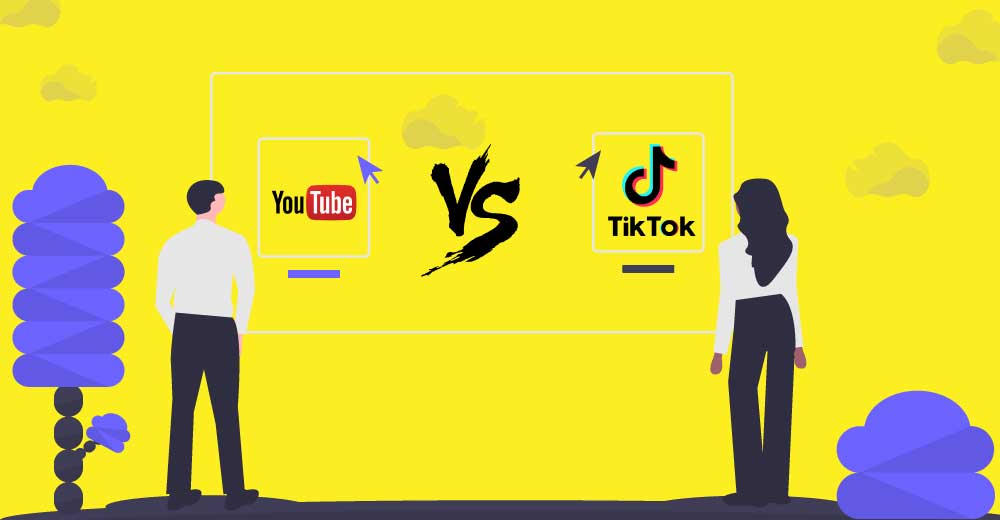As soon as the pandemic hit India, with 1.3 billion population under lock-down, there was a sudden +60% spike in consumption of online video content within the first two weeks.
Battle between two specific video-sharing platforms, YouTube vs TikTok has caught like wildfire and is breaking the internet to uphold the rise of the better platform.
YouTube
· 20.5% surge in subscribers-base during the 45 days of the lockdown
· Millennials remain the most active group on YouTube in India.
· Currently, over 90% of the views on YouTube are through Mobile devices.
TikTok
· Largest user base in India, accounting to 30.3% of its overall users
· An average of 52 minutes per day/per user is spent on the app
· 60% of TikTok users are Gen Zers
Let’s talk about the key differentiators, consumer benefits and how are these two platforms managing their customer relations?
Audience – Consumers and Content creators
The largest demographic of TikTok users are Gen Zers between the ages of 16 and 24. Tier 2 & 3 cities are more prevalent on TikTok with homegrown content popping up on the app. This is also boosted due to JIO penetrating affordable mobile internet packages. The majority of the Indian audience prefers TikTok as a platform from a creator’s standpoint, due to its simplicity and ease to create quick bite-sized content.
8.1% of YouTube viewers are in India 93% of video watchers are watching on this platform according to businessworld.in. 60% of the watch time coming from outside of the six largest metros in India. While creating content may not be as easy as on TikTok, due to the fact of needing quality filming equipment and skills to post-production tools, there is still a steady growth in the number of creators with almost 1,200+ of them crossing the million subscribers mark.
Algorithm
TikTok is turning towards AI for success. Its AI tool is more powerful than any other social media platform in the world. The apps AI dictates the entire feed. The more a user engages with the feed, the more it learns what you like. The algorithm takes into account how fast the user scrolls through each video and learns interests from the time spent on each swipe.
YouTube still recommends and gives users the choice to choose videos basis their interest. TikTok however, progressively dictates what the user sees on their screen. Giving the user no choice in the ‘recommended’ scroll, keeping the user hooked which has been integral to TikTok’ success.
User Value
They say, knowledge is power and indeed YouTube has become one of the leading platforms where users can search to learn anything new. For example, someone who doesn’t know how to use TikTok has a variety of lengthy videos to choose from to learn how to use this new platform. The category of ‘infotainment’ is never-ending.
On TikTok the videos were limited to 15 seconds but recently the company extended the time limit to 60 seconds. Even then, keeping the time limit in mind, it’s fair to wonder what is the true value for a user?
Though on the off-set content on the app may come across as cringy and a waste of time, a little time spent on the app can, however, bring to one’s attention its initiatives to make the app add true value to a consumer. Few examples can be recent campaigns to spread awareness about COVID-19, Tips to stay hygienic, Facts about the virus. Free courses to learn Digital Marketing, ‘Study at home’ offering free online coaching for CBSE student from class 9th – 12th, etc; adding true value for the user
Monetisation
In recent years, quitting one’s day job and becoming a fulltime “influencer” or YouTuber has become a trend of its own. It’s a very well-known fact that well-established Influencers on YouTube make millions of dollars for their content. The same pattern is slowly catching up on TikTok. Of course, there are certain criteria to be met before a creator can commence monetization on both these platforms; Age restriction, follower/subscription limitation & number total video clicks/views with all the videos put together.
· Youtuber creators can earn 68% of Ad Revenue on each video – This is the most common way of making money on this platform. They get paid for allowing GDN Ads as in video placements, bumper ads, or banners around their video.
· There are other ways to make money on YouTube for an established creator. Channel Sponsorships with brands for product placements/shout outs or reviews. Selling their own merchandise or even enabling their channel to be premium where members have to pay for a subscription.
· TikTok creators don’t make any money through Ad Revenue, though the platforms’ key business model is Ad Spends.
· There are however loopholes to make money on TikTok. Brand collaboration and product placements through sponsorships is most common. Viewers can click the bottom centre of the screen, a list of products being used or featured in the video pops up. The half-screen includes the price and link which redirects to the brand’s e-com page for purchase. The creator is paid through a commission model.
Unity of creators
YouTube has always had a strong community mindset. A creators program where the platform offers studio space in various cities around the globe. These spaces are created with sole purposes for creative inspiration and place to meet, collaborate, and film with other creators.
Creators and fan meet-ups have always been encouraged by YouTube to get to know their audience outside of a screen. This trend of influencer meet-up is slowly catching up with TikTok’s creators as well.
TikTok also allows users to register for their creator’s program which gives added benefits such as getting a dedicated community manager to assist with any non-technical account. They also receive early access to features and notifications on upcoming in-app campaign challenges or trending hashtags.
Both platforms offer exclusive invites to events hosted or sponsored by the platform. In-depth insights and analysis can also be used to optimise content and drive more views and engagement.
Advertiser – TikTok has slowly evolved from a short video-creation app meant specifically for users to a marketing and advertising haven. YouTube on the other hand has an upper hand when it comes to advertising as brands can test multiple ad-formats, right from preroll, bumper, in-stream, and even display ads and optimize the campaign and budgets according to the TG engagement with the communication which has been presented.
TikTok however drives more user-generated content with its campaigns and the success can be measured with the number of short-videos the TG has uploaded. Of course, the clicks and reach of the campaigns can all be measured but the audience involvement in a campaign on TikTok cannot be beaten.
Some notable challenge-driven campaigns on TikTok which generated a lot of UGC –
Pepsi – #SwagStepChallenge
Dettol – #HandWashChallenge
Parachute – #ChampiBeats
Clean & Clear – #UnbottleApnaSwag
Flipkart – #BigBillionStar
Want to evaluate your ROI on marketing on YouTube or TikTok?
Talk to Clevertize!
Clevertize is one of the Top Integrated Marketing Communication Agencies in India. It has worked with many national & international clients like eBay, Nando’s, David Lloyd UK, METRO Cash & Carry, Sobha Ltd., TATA Motors, Barbeque Nation to name a few.
Clevertize is an Award Winning Agency, known to marry marketing with technology.
Some of the services that Clevertize provides are:
Creative Services, Performance & Digital Media Marketing, Visual Identity & Branding, Campaign Management & Analysis, UI/UX & Website design, Video creation, Media planning & buying, Chatbot & more.
If Return on Investment is critical for you, talk to Clevertize!





